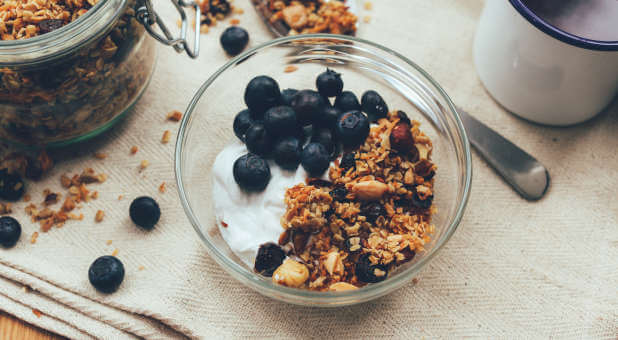Food marketers are clever. They know you’re looking for some healthier options, so they provide so-called “healthy” options. Yet, many of them are not healthy at all.
Let’s debunk five foods most think are healthy, but aren’t, and what to eat instead.
- Fruit juice: Visiting a patient at the hospital the other day, I overheard someone asking a patient what kind of juice they wanted with dinner. The patient explained that they were diabetic and should just have water, but the person taking the order convinced them to order juice anyway because “you need your vitamins.”
Even 100% fruit juice does contain vitamins and minerals. But it’s a concentrated source of sugar that hits your bloodstream like a bag of Skittles.
On top of this, many juices in the grocery store only have a small percentage of real fruit juice. The rest of the container is filled with added sugar or high fructose corn syrup.
When you take fruit and squeeze the juice out of it, you leave behind its fiber and a broad range of nutrients. All that’s left is a super-sweet, tasty beverage that contains a lot of calories and doesn’t fill you up.
In fact, it ramps up your blood sugar and ensures you’ll crave more sweets in no time.
Instead of drinking juice, get the vitamin and mineral benefit by eating 2-3 servings of whole fruit every day. Or, toss some whole fruit in a blender along with protein powder and unsweetened coconut or almond milk, and enjoy a nice smoothie.
- Granola and whole-grain cereals: Granola and other whole-grain cereals are advertised as one of the healthiest breakfast options. But with an ingredient base that’s mostly grains and sugar, you start the day down a path of sugar cravings and weight-gain.
You probably already know that sugar is not good for you, but we also recommend staying away from grains. Yes, even whole grains.
Yes, granola is tasty, which explains why it’s hard to stop eating. So, we’re not going ask you to stop. We’re going to ask you to swap.
Instead of eating packaged granola, grab some pecans, walnuts, chia seeds, flax seed meal, and unsweetened shredded coconut. Mix your ingredients, put them in a food processor and pulse until you get the texture you want.
If you want more crunch, toss the mixture in a small amount of coconut or olive oil, spread it out on a baking sheet, and bake at 325 degrees for about twenty minutes.
- Flavored yogurt: The problem isn’t the yogurt. It’s everything they add to the yogurt to keep you coming back.
With labels like “fat-free” and “contains real fruit,” consumers are tricked into eating something that is chock full of sugar, preservatives—sometimes fat—and often artificial flavors and colors.
The worst part of it is we’ve been tricked into thinking these flavored yogurts are a healthy snack for our kids. So we add them to their lunch or use them to supplement their breakfast. In essence, we’re giving them a handful of sugar disguised as something healthy.
Now, we are not saying you have to stop eating yogurt, unless you have a dairy sensitivity of course. But swap the flavored yogurt for plain Greek yogurt.
Yogurt should only have two ingredients: milk and active cultures.
If you want to sweeten things up, add some fresh fruit or a natural, no-calorie sweetener, like stevia leaf extract.
And for an extra-special treat, top it with your homemade granola!
- Trail mix— What’s so unhealthy about a mixture of nuts? Nothing.
But we all know that trail mix sneaks in some stowaways. Candy, yogurt-covered raisins and fried banana chips, to name a few. And on top of it all, there is usually added sugar.
At least there is dried fruit, right?
Even though dried fruit contains fiber, vitamins and minerals, many suppliers add sugar to make it taste better and preservatives to make it last for years. Even without the sugar, you’re much better off eating fresh fruit than dried fruit.
So, swap the trail mix with your own mix of raw nuts and seeds. You can even add a little high-cocoa dark chocolate for that special touch.
- Wheat bread— Whole wheat bread may actually be white bread with a little bit of whole wheat flour mixed in. And in most cases, this wheat bread actually spikes your blood sugar more than white bread because they add sugar to make it taste better.
We actually recommend staying away from most bread. There’s really not much of a health benefit regardless of what type of bread it is. (Yes, we know the Bible is full of positive references to bread, but this was before genetically modified forms of wheat overtook the fields.)
The overuse of bread and grains in our society is a key contributor to the obesity epidemic.
If you are craving a sandwich, swap the bread for lettuce, sliced bell pepper, grilled sweet potato or eggplant.
Finally, Beware of a ‘Fat-Free’ Feast
Be skeptical of any product labeled fat-free—especially if it tastes amazing. Most of these products replace the fat with sugar. And as medical research continues to post out, fat is not the primary enemy, sugar is.
The same thing goes for products labeled gluten-free. These are usually highly processed and have added sugar or starch.
A healthy diet, and healthier holiday snacking, is actually pretty simple. Focus on lean meats, quality fats and raw fruits and vegetables. Leave all the packaged stuff behind. {eoa}
Mark Sherwood, naturopathic doctor (ND) and his wife, Michele L. Neil-Sherwood, D.O., are on a mission to help you achieve wellness in every area of your life. Drs. Michele and Mark have a successful medical practice, the Functional Medical Institute, and provide resources to provide relief from stress and live well. They also offer a free recipe book. https://fmidr.com.











































